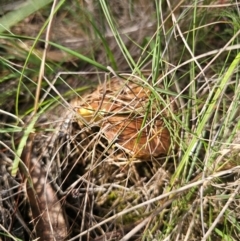Suillus luteus (Slippery Jack)
The fruit body is a bolete with a cap atop a central stem. The cap is convex but may flatten with age and is up to 15 centimetres in diameter. It is some shade of brown (from yellow-brown to chocolate-brown or purple brown), smooth and very slimy when fresh or in moist conditions. The pored underside is some shade of yellow and the stem is white to yellowish, up to 10 centimetres long and 3 in diameter.
There is partial veil that covers the pored surface in the immature bolete and remains in the mature bolete as a ring of tissue around the stem. There is no universal veil.
Spore print: brown.
In dry conditions that slimy layer will probably be absent but it may have left evidence. As the bolete grew up from the ground bits of leaf litter may have become stuck to the slimy layer. When the slime dries such litter remains firmly glued to the cap and if you try to remove a stuck leaf you will almost certainly pull off some of the cap tissue as well. Fungi with non-slimy caps may also pick up leaf litter as they grow up from the soil, but in such cases the attachment is weak and the litter can be brushed off easily with no damage to the cap.
In this photo (http://www.cpbr.gov.au/fungi/images-captions/suillus-luteus-0117.html) you see the slimy cap, some leaves stuck to the slime and the veil remnant (on part of which there is a brown spore deposit).
This is a species introduced to Australia from the northern hemisphere. In our area you see it most commonly near pine trees with which it forms a mycorrhizal association.
It should not be possible to confuse this with any other species.
Suillus luteus is listed in the following regions:
Canberra & Southern Tablelands
Species information
- Suillus luteus Scientific name
- Slippery Jack Common name
- Not Sensitive
- Exotic
- Non-invasive or negligible
- Up to 1254.1m Recorded at altitude
- Machine learning






































